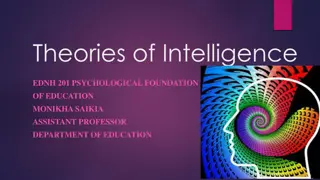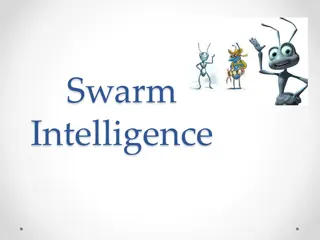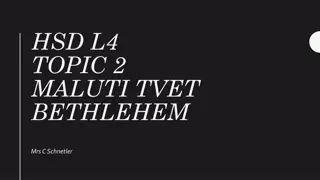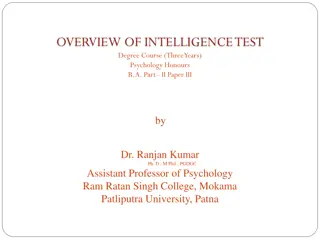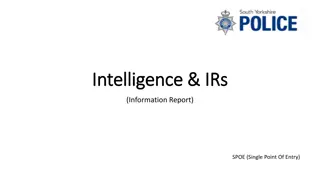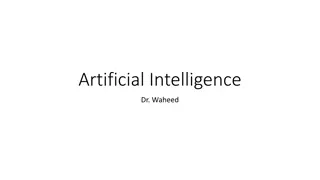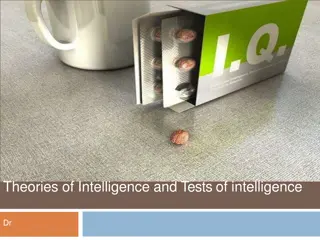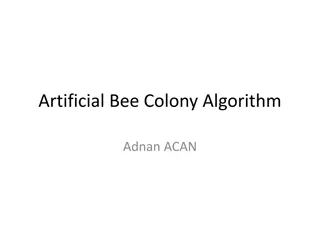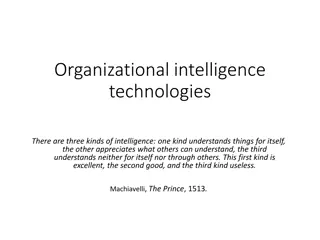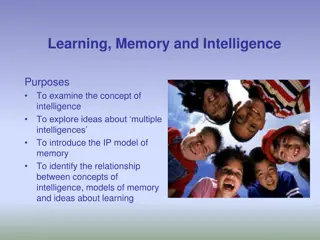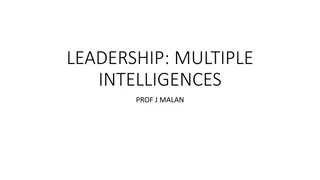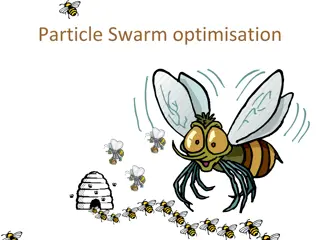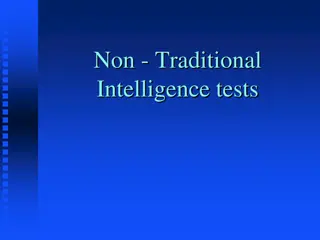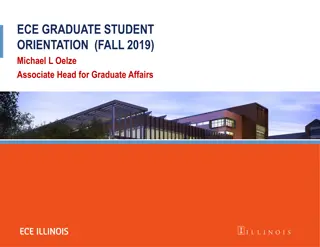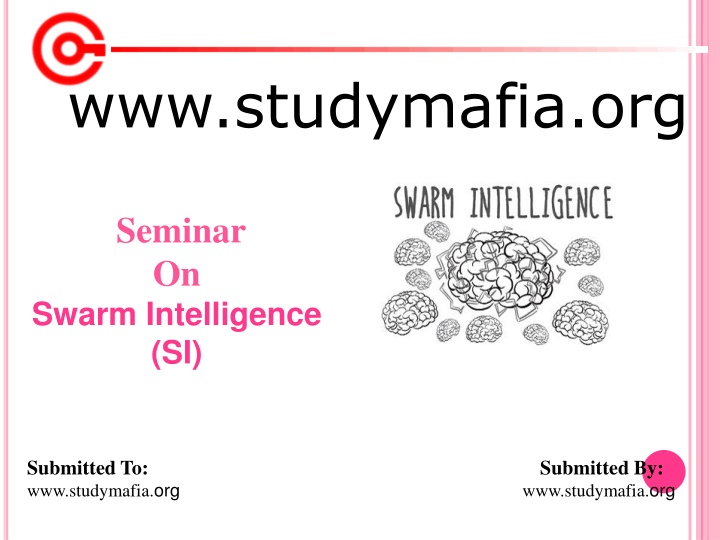
Exploring Swarm Intelligence: Nature-Inspired Collective Behavior
Discover the fascinating world of Swarm Intelligence (SI) through this seminar presentation. Learn about the origins, examples from nature, applications in robotics, and recent developments in this artificial intelligence technique based on decentralized systems. Explore how groups of interacting agents emulate the collective behavior seen in swarms in nature, such as bees, ants, birds, and more. Dive into the realm of Swarm Intelligence and its significance in modern AI research.
Download Presentation

Please find below an Image/Link to download the presentation.
The content on the website is provided AS IS for your information and personal use only. It may not be sold, licensed, or shared on other websites without obtaining consent from the author. If you encounter any issues during the download, it is possible that the publisher has removed the file from their server.
You are allowed to download the files provided on this website for personal or commercial use, subject to the condition that they are used lawfully. All files are the property of their respective owners.
The content on the website is provided AS IS for your information and personal use only. It may not be sold, licensed, or shared on other websites without obtaining consent from the author.
E N D
Presentation Transcript
www.studymafia.org Seminar On Swarm Intelligence (SI) Submitted To: www.studymafia.org Submitted By: www.studymafia.org
OUTLINE Background What is a Swarm Intelligence (SI)? Examples from nature Origins and Inspirations of SI Ant Colony Optimization Particle Swarm Optimization Summary Why do people use SI? Advantages of SI Recent developments in SI
WHATISA SWARM? A loosely structured collection of interacting agents Agents: Individuals that belong to a group (but are not necessarily identical) They contribute to and benefit from the group They can recognize, communicate, and/or interact with each other The instinctive perception of swarms is a group of agents in motion but that does not always have to be the case. A swarm is better understood if thought of as agents exhibiting a collective behavior
SWARM INTELLIGENCE (SI) An artificial intelligence (AI) technique based on the collective behavior in decentralized, self- organized systems Generally made up of agents who interact with each other and the environment No centralized control structures Based on group behavior found in nature
EXAMPLESOF SWARMSIN NATURE: Classic Example: Swarm of Bees Can be extended to other similar systems: Ant colony Agents: ants Flock of birds Agents: birds Traffic Agents: cars Crowd Agents: humans Immune system Agents: cells and molecules
SI - THE BEGINNINGS First introduced by Beni and Wang in 1989 with their study of cellular robotic systems The concept of SI was expanded by Bonabeau, Dorigo, and Theraulaz in 1999 (and is widely recognized by their colleges) Using the expression swarm intelligence to describe only this work seems unnecessarily restrictive: that is why we extend its definition to include devices inspired by the collective behavior of insect colonies and other animal societies
SWARM ROBOTICS Swarm Robotics The application of SI principles to collective robotics A group of simple robots that can only communicate locally and operate in a biologically inspired manner A currently developing area of research
WITHTHE RISEOF COMPUTER SIMULATION MODELS: Scientists began by modeling the simple behaviors of ants Leading to the study of how these models could be combined (and produce better results than the models of the individuals) Giving us insight into the nature of humans, society, and the world Further leading to adapting observations in nature to computer algorithms
WHY INSECTS? Insects have a few hundred brain cells However, organized insects have been known for: Architectural marvels Complex communication systems Resistance to hazards in nature In the 1950 s E.O. Wilson observed: A single ant acts (almost) randomly often leading to its own demise A colony of ants provides food and protection for the entire population
TWO COMMON SI ALGORITHMS Ant Colony Optimization Particle Swarm Optimization
ANT COLONY OPTIMIZATION (ACO) The study of artificial systems modeled after the behavior of real ant colonies and are useful in solving discrete optimization problems Introduced in 1992 by Marco Dorigo Originally called it the Ant System (AS) Has been applied to Traveling Salesman Problem (and other shortest path problems) Several NP-hard Problems It is a population-based metaheuristic used to find approximate solutions to difficult optimization problems
WHATIS METAHEURISTIC? A metaheuristic refers to a master strategy that guides and modifies other heuristics to produce solutions beyond those that are normally generated in a quest for local optimality Fred Glover and Manuel Laguna Or more simply: It is a set of algorithms used to define heuristic methods that can be used for a large set of problems
ARTIFICIAL ANTS A set of software agents Stochastic Based on the pheromone model Pheromones are used by real ants to mark paths. Ants follow these paths (i.e., trail-following behaviors) Incrementally build solutions by moving on a graph Constraints of the problem are built into the heuristics of the ants
USING ACO The optimization problem must be written in the form of a path finding problem with a weighted graph The artificial ants search for good solutions by moving on the graph Ants can also build infeasible solutions which could be helpful in solving some optimization problems The metaheuristic is constructed using three procedures: ConstructAntsSolutions UpdatePheromones DaemonActions
CONSTRUCTANTSSOLUTIONS Manages the colony of ants Ants move to neighboring nodes of the graph Moves are determined by stochastic local decision policies based on pheromone tails and heuristic information Evaluates the current partial solution to determine the quantity of pheromones the ants should deposit at a given node
UPDATEPHEROMONES Process for modifying the pheromone trails Modified by Increase Ants deposit pheromones on the nodes (or the edges) Decrease Ants don t replace the pheromones and they evaporate Increasing the pheromones increases the probability of paths being used (i.e., building the solution) Decreasing the pheromones decreases the probability of the paths being used (i.e., forgetting)
DAEMONACTIONS Used to implement larger actions that require more than one ant Examples: Perform a local search Collection of global information
APPLICATIONS OF ACO Vehicle routing with time window constraints Network routing problems Assembly line balancing Heating oil distribution Data mining
TWO COMMON SI ALGORITHMS Ant Colony Optimization Particle Swarm Optimization
PARTICLE SWARM OPTIMIZATION (PSO) A population based stochastic optimization technique Searches for an optimal solution in the computable search space Developed in 1995 by Dr. Eberhart and Dr. Kennedy Inspiration: Swarms of Bees, Flocks of Birds, Schools of Fish
MOREON PSO In PSO individuals strive to improve themselves and often achieve this by observing and imitating their neighbors Each PSO individual has the ability to remember PSO has simple algorithms and low overhead Making it more popular in some circumstances than Genetic/Evolutionary Algorithms Has only one operation calculation: Velocity: a vector of numbers that are added to the position coordinates to move an individual
PSYCHOLOGICAL SYSTEMS A psychological system can be thought of as an information-processing function You can measure psychological systems by identifying points in psychological space Usually the psychological space is considered to be multidimensional
PHILOSOPHICAL LEAPS REQUIRED: Individual minds = a point in space Multiple individuals can be plotted in a set of coordinates Measuring the individuals result in a population of points Individuals near each other imply that they are similar Some areas of space are better than others Location, location, location
APPLYING SOCIAL PSYCHOLOGY Individuals (points) tend to Move towards each other Influence each other Why? Individuals want to be in agreement with their neighbors Individuals (points) are influenced by: Their previous actions/behaviors The success achieved by their neighbors
WHAT HAPPENSIN PSO Individuals in a population learn from previous experiences and the experiences of those around them The direction of movement is a function of: Current position Velocity (or in some models, probability) Location of individuals best success Location of neighbors best successes Therefore, each individual in a population will gradually move towards the better areas of the problem space Hence, the overall population moves towards better areas of the problem space
PERFORMANCEOF PSO ALGORITHMS Relies on selecting several parameters correctly Parameters: Constriction factor Used to control the convergence properties of a PSO Inertia weight How much of the velocity should be retained from previous steps Cognitive parameter The individual s best success so far Social parameter Neighbors best successes so far Vmax Maximum velocity along any dimension
APPLICATIONS OF PSO Human tremor analysis Electric/hybrid vehicle battery pack state of change Human performance assessment Ingredient mix optimization Evolving neural networks to solve problems
PSO AND EVOLUTIONARY ALGORITHMS PSO algorithms have been and continue to greatly influenced by evolutionary algorithms (EA) i.e., methods of simulating evolution on a computer Are sometimes considered a type of evolutionary algorithm but viewed to be an alternative way of doing things Some differences: The concept of selection is not considered in PSO EA uses fitness ,while PSO uses individuals and neighbors successes, to move towards a better solution
WHY DO PEOPLE USE ACO AND PSO? Can be applied to a wide range of applications Easy to understand Easy to implement Computationally efficient
ADVANTAGESOF SI The systems are scalable because the same control architecture can be applied to a couple of agents or thousands of agents The systems are flexible because agents can be easily added or removed without influencing the structure The systems are robust because agents are simple in design, the reliance on individual agents is small, and failure of a single agents has little impact on the system s performance The systems are able to adapt to new situations easily
RECENT DEVELOPMENTSIN SI APPLICATIONS U.S. Military is applying SI techniques to control of unmanned vehicles NASA is applying SI techniques for planetary mapping Medical Research is trying SI based controls for nanobots to fight cancer SI techniques are applied to load balancing in telecommunication networks Entertainment industry is applying SI techniques for battle and crowd scenes
CONCLUSION Provide heuristic to solve difficult problems Has been applied to wide variety of applications Can be used in dynamic applications
REFERENCES www.google.com www.wikipedia.com www.studymafia.org www.projectsreports.org 33

